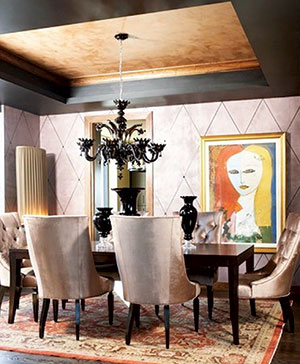Art, Seriously
Writer John ZeamanGallery owners offer advice on how to form an art collection.
You’ve redone the house. The paint is dry, the furniture is in place and you’re looking at the new, empty walls. Standing by is your assortment of artwork: the Italian landscape from your mother’s house, two beachy watercolors, some Ansel Adams photographs, oil portraits of the kids, two abstract paintings you bought in your twenties…
You love your old collection. Everything has meaning for you. But it’s not quite a real art collection, is it? You’re thinking it’s time to get more serious, to acquire art in a purposeful way. But how do you begin to build a collection?
We consulted with some New Jersey art dealers: Jill Paul of Designs for Tranquility in Frenchtown, James Yarosh of James Yarosh Associates Fine Art Gallery in Holmdel and Kathleen Palmer of Studio 7 Fine Art Gallery in Bernardsville.
Despite the media buzz about art as an investment and stories about young artists whose works are soaring in value, the dealers warn against buying art because you think it will appreciate in value. “Don’t buy something because it’s the hottest new thing,” Paul says.
Their advice is simple: Go with your eye and your heart, not your business sense. “Buy what you love” is the universal mantra.
First, Prepare
That said, don’t be impulsive and fall in love right away. Unless you’re already very knowledgeable, there’s homework to be done. “Before you can buy what you love, you have to learn what it is that you love,” says Paul, who, like the others, recommends visiting museums and galleries, reading books and researching on the Internet.
Yarosh, whose specialty is contemporary Russian realism, points people toward Sister Wendy Beckett, the star of a BBC art series in which she sweetly explained old master paintings—including nudes and scenes of terrible violence—in terms that anyone could understand. “I give her books to clients for Christmas,” he says.
Palmer sends clients to exhibits at New York’s Salmagundi Club, an organization of realist artists. And because she also handles glass artists, she has hosted glassblowing demonstrations at Vandermark–Merritt Glass Studios in Branchburg so clients can see the process firsthand.
Don’t Cheap Out
Beginning art collectors are sometimes advised to collect in the more affordable fields, such as prints or photographs, which are produced in multiples. But once you settle on a medium or genre, you shouldn’t scrimp by buying the cheapest example you can find.
“I tell them to find an artist they like and then pick the best example of that artist’s work,” Palmer says. Often, that may turn out to be the most expensive one, but there are ways around that. Most dealers, for example, are open to payment arrangements. Yarosh bought his first painting when he was 18 and working at an art gallery. He paid $50 a week out of his salary until it was paid for.
“If you fall in love with a 40-by-60-inch painting and it costs $20,000, find a smaller piece by that artist or a work on paper,” Paul says.
Different Styles?
People sometimes imagine that art collections need to be uniform in style. Not so, the dealers say. Plenty of good collections are eclectic. The trick is in displaying the art.
“Think of the mood you’re trying to create in a room,” Paul says. “If you’re true to that mood, it doesn’t matter if the paintings are in different styles.” She points out that a common color can tie different pieces of art together, even if one is abstract and one is a landscape.
Yarosh, who also runs a design service, says frames are the way to go when you want to pull things together—and to connect art to the décor. “You can take an eclectic collection of different styles and periods and put everything in the same white floater frames. Then you can hang them in a modern interior,” he says. “You can do the same with ornate gold frames if you’re trying to fit the art into a more traditional room. The frames make an architectural unity.”
Another solution is to create individual galleries. “I have clients who put different kinds of art in different rooms so they have mini-collections within the house,” Palmer says.
What happens when you have more art than you have wall or floor space? Yarosh likes to stack paintings on the wall, but not all of his clients like that style. “People say they don’t want their home to look like a museum,” he says. As a museum lover, he doesn’t see that as a problem. “I say we should all be so lucky.”
If you want to make art dealers cringe, tell them you like a painting “but that it doesn’t go with my couch.” To them, that’s the tail wagging the dog.
“Art isn’t something you buy to decorate with,” Palmer says.
“If you truly love a work of art, you’ll find a way to make it fit,” Paul adds.
And if you can afford the luxury, you can go the other way and decorate around the painting. “It’s a very European thing to start with a painting and work backward by creating the three-dimensional room around it,” Yarosh says. “You can make a dialogue that way. You can make everything sing together.”
John Zeaman is a noted art critic and author and also is Design NJ’s longtime art columnist.



